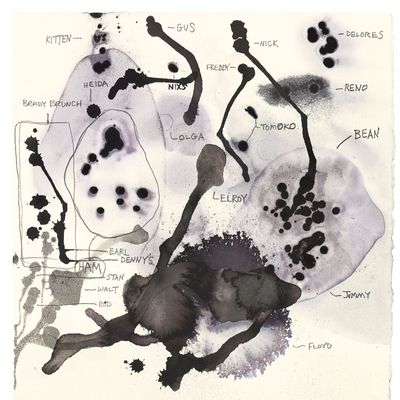
Almost 70 works from the Morgan Library’s wunderkammer collection have been organized by artist Nina Katchadourian in her new show, “Uncommon Denominator.” Her own work is installed alongside diaries, maps, a UFO photograph, a seaweed specimen, bookbinder tools, bric-a-brac, and various arcana. Dates range from 3,400 BCE to the present. Sections of the show are accompanied by short statements by Katchadourian, 54, about visual coincidence, record-keeping, mending, how one kind of art might refer to another kind of art, geography, and, crucially, how to survive at sea. The whole calls to mind Jorge Louis Borges’s taxonomy of fictitious animals, organized into numerous categories, including “those that belong to the Emperor,” “embalmed ones,” and “those that tremble as if they were mad.” Katchadourian’s phenomenological exercise similarly encourages free-floating slippages in thinking, the euphoric discovery of hidden connections.
Katchadourian is something of an insider outsider, who has shown all over the world but not a lot of late in New York. She’s a conjuror conceptualist with a tinkerer’s touch, eccentric and cerebral. Born to a Swedish mother who grew up in Finland and an Armenian father raised in Beirut, Katchadourian went to school in California and now divides her time between New York and Berlin. Her father was a psychiatrist, a former dean at Stanford, and a professor of human biology; her mother, a literary translator, writer, and an expert in Esperanto. Katchadourian has written about meals in which conversations were carried on in four languages.
Katchadourian has a need to restore things. Using tweezers, thread, and glue, she repaired damaged spider webs on an island in Finland in 1998. Overnight, the spiders excised her fixes, dropped them to the ground, and carried out their own fixes. Louise Bourgeois called the spider “a repairer,” an occupation that Katchadourian interpreted as an “attempt to keep things together and make things whole.” She has also patched damaged mushrooms with a bicycle-repair kit; another astounding work is a small plastic lid that her maternal grandfather meticulously repaired in 1959.
Katchadourian imposes meaning on things that catch our attention but may be meaningless. In 1993 she labeled patterns and colonies of rock lichen according to the islands they resembled: Iceland, Ireland, Australia, Hawaii. She’s a pattern-recognition machine who has tried to translate the sound of popcorn popping into Morse code. In Lavatory Self-Portraits in the Flemish Style (2011), Katchadourian entered airplane bathrooms, adorned herself in tissue and toilet paper, and took pictures of herself in the style of Flemish self-portraits.
“Uncommon Denominator” is about the delight taken in close observation, obsession, natural science, documentation, found objects, anonymous photographs, and other strange paraphernalia. These include a foldout, three-dimensional rendition of a tunnel under the Thames from 1830. In the anatomy section, there’s a beautiful Watteau drawing from 1716, and her own anatomy book from the 1970s. Also on hand is her 1981 Beatle Log, noting every Beatle song heard on the radio. Elsewhere are locks of hair decoratively arranged; John Pierpont Morgan’s own diary of steamers from Liverpool; and a book of autographed letters between Walt Whitman and his mother — only every example has been cut out. It’s a ghost book.
One wall is devoted to the 1973 book Survive the Savage Sea. This is a saga of six people enduring 27 days on the Pacific Ocean in a six-foot dingy. Katchadourian has read the book over 40 times. She presents numerous other books whose covers are arranged to retell the story of setting to sea, being wrecked, becoming castaways, battling the ocean, and being rescued. Katchadourian uses survival as a grand metaphor for what being an artist is: hyperattentive, mentally flexible, adaptable, and creative in any space, with any material at hand.

